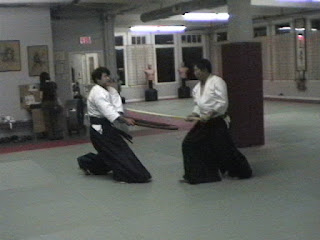ShoChikuBau sword and sensing
I just posted a Zoom class video on Youtube. Usually I quickly scan and post. But this was Friday April 9th and really got my attention. So in addition to posting I am also blogging. The class began with a recount of Osensei and the phantom swordsman. During his World War II retreat in Iwama, A phantom of himself appears and they engage in swordplay. At first he cannot beat the phantom. But as the days progress he is able to anticipate the moves of the ghostly or spirit swordsman and is finally able to more than match him. And the experience leads to very important spiritual insights on Osensei's part. The narrative is at the beginning of the video.
And Osensei refers to the swordplay as Shochiku bai. That is something Hikitsuchi sensei sensei taught at the Shingu dojo. Not a set or a kata but something very distinct. In my second stay I had more position at the dojo and so Hikitsuchi sensei would call me up when demonstrating the sword. Those were very intense experiences every time he would demonstrate the sword. And I had little to no experience with the bokken. But I like to think he was so good he made me look like I knew what I was doing. The experience was what he referred to as shinken, training with the feel that it was done with live blades(we were using bokken, of course). Everything was in the moment, nothing to know or reflect on. But sort of burned into my soul memory.
Sho represented plum and the triangle It was called zettai fuhai na taisei or the posture of invincibility. Chiku was bamboo or the circe, and the teaching associated with it was the circle has no center. Bai was the pine, radially symmetrical having no front or back. I made the association that this was also related to the zoka no sanshin or the 3 origins Ikumusubi, tarumusubi, and tamatsume musubi. One of the reasons I mention this is this is material that has no virtual interest in today's Aikido. But when I was in Japan in the early to mid seventies along with Mary Heiny and Linda Holiday, we were encouraged to leave no stone unturned in our quest to absorb the essence of what Aikido truly is. So any sense of Osensei's words were considered to have knowledge and power associated with them. It is amazing to me that much of what has sustained me during this pandemic has been going over Osensei's words and reliving my own direct experiences surrounding them.
So what caught my attention about the video was the importance of the word sense. Osensei often talked about how misogi was to cleanse the 6 senses. That is the 5 obvious ones and the 6th is translated by John Stevens as mind. I asked Mary Heiny what she thought was the Japanese word that Mr Stevens translated as mind, and she thought it was nen. And that is the thought/moment/instant. My current thought is that our 5 obvious senses are in Osensei's words contaminated because they tie us to a very limited reality and a corresponding limited sense of self. Misogi practices are not just to unclog our 5 senses but the awaken a dormant sense that senses the finer dimensions of what constitutes reality and also awakens correspondingly finer and finer levels of ourselves. As we are able to sense/feel the finer dimensions of the universe we also awaken the finer more original levels of our own being. Being able to sense kami leads us to our own nature as kami.
Did Osensei really meet himself as a ghost or spirit swordsman? Or did his Overself come to him in the form of pure ki and coach him to his next level. Osensei said after the encounter, which lasted weeks, he felt revitalized. And he could sense/feel the whole universe in his belly. How much of our own ability to understand Osensei is tied to our own growth in our ability to sense the finer levels of the creation'/universe? What troubles me about Aikido these days is that we settle for so much less. Hopefully when we are able to re-open and along with other things begin together to explore this.
So the video is long, 1 hour 40 minutes. But it is good. At the end I go into 2 people I study that I feel did/do something of what Osensei did. Chet Baker, the jazz great , and his ability to channel sound and phrasing through his empty spaces. And Stephen Curry with his ability to be an absolute master of using stillness to set up his motion. We are vast and ultimately universal in scope. And we can settle for so much less. Be safe and well.




0 Comments:
Post a Comment
<< Home